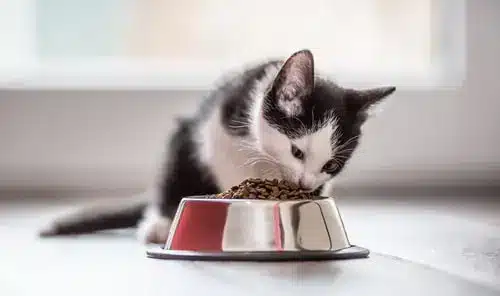Home » Blog » Pet » Pet Parenting Lifestyle » Yay or Nay – Can Kittens Eat Adult Cat Food?
Categories
Tags
animal welfare
breed profile
buying a car
buying a pet
Car
car accessories
car care
car features
car insurance
Car safety
car sales
car service
cat
cat behaviour
cat body language
Cat Breeds
cat food
cat insurance
comprehensive car insurance
Dog
Dog Behaviour
dog body language
Dog Breeds
dog food
Dog Insurance
dog training
eco friendly cars
Kitten
New Car
pet accessories
pet activities
Pet Adoption
pet breeders
pet days of the year
pet fun stuff
Pet Health
pet insurance
pet parenting
Pet Safety
pet services
Puppy
rescue pets
road safety
road trip
safe driving
Recent Blog:
Facebook Posts
1 day ago
Growing old sometimes means we can’t take care of pets anymore. Find out some advice on what to do when this happens:![]()
![]() Senior Pet Parents – Contingency Plans for Your Pet – bit.ly/44bzwkS
... See MoreSee Less
Senior Pet Parents – Contingency Plans for Your Pet – bit.ly/44bzwkS
... See MoreSee Less
Senior Pet Parents' Contingency Plans for Pets
www.pd.com.au
Sometimes senior pet parents need more downtime. For older pet owners, this can be tricky to navigate if their dog or cat is full of beans and wants to3 days ago
Before you rev up the engine, let’s run through a checklist of things to do before starting your car. Not only do these steps ensure your safety (and that of others around you), but they also help in maintaining your vehicle's longevity.![]()
![]() Driving Tips: Your Checklist Before Starting Your Car -
... See MoreSee Less
Driving Tips: Your Checklist Before Starting Your Car -
... See MoreSee Less
Driving Tips: Your Checklist Before Starting Your Car
www.pd.com.au
Heading out for a drive? Hold up a second! Whether you're dashing off to work, running errands, or embarking on a road trip adventure, there are a few1 week ago
Are intestinal worms setting up camp in your dog’s gut without paying rent? Here’s how to spot the main culprits and get rid of them too:![]()
![]() Preventing, Identifying and Treating Intestinal Worms in Dogs - bit.ly/43YjCKu
... See MoreSee Less
Preventing, Identifying and Treating Intestinal Worms in Dogs - bit.ly/43YjCKu
... See MoreSee Less
Preventing, Identifying and Treating Intestinal Worms in Dogs
www.pd.com.au
Intestinal worms, such as roundworms in dogs are one of the least glamorous topics on the planet. These intestinal parasites that basically use our dogsThey say you are what you eat. But how does this translate to pet food and to kitten food in particular? Can kittens eat adult cat food, for example? When do kittens start eating food and drinking water? And how much wet food to feed a kitten, or is dry food best?
As much as it seems like the questions are endless, the answers are all right here. Let’s dive in to unpack all you need to know about being a new kitten parent and feeding them well.
Table of contents
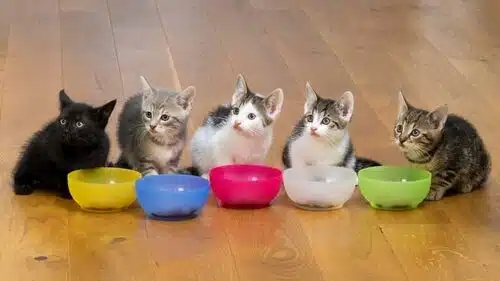
When do kittens start eating food and drinking water?
Kittens aren’t born with teeth; in any case, not visibly so. They’re there but just hidden under the gums. These baby teeth start emerging around three weeks and are fully out by roughly six to eight weeks. In between this time at around the five week mark they start to gradually drink less and less of mummy cat’s milk.
In other words, kittens can start taking their first taste test of kitten food at about five weeks old. Kibble will be too hard for them to eat properly but you sprinkle a bit of water on it to soften it. Be sure to also give them some wet food because they won’t be able to pack in enough nutrition with dry food alone.
To sum it up kittens start to gradually move onto eating food and drinking water from five weeks onwards. But it’s still baby steps here as they need mum’s milk and the maternal antibodies this provides.
Between seven and 12 weeks they’ll become fully weaned. Their milk teeth will have completely emerged and they can happily move onto a diet of kitten food. Read all about keeping cat teeth good as new their whole life long.
Biting is bad. These little teeth are sharp and they might want to bite you, which isn't a good idea. Read all about how to stop a cat biting you. Vaccinations are good. Make sure kittens are vaccinated once weaned as they'll lose natural immunity. Our kitten and cat health checklist includes your kitten's vaccination schedule.
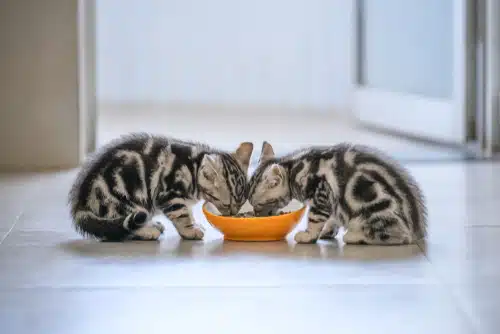
Can kittens eat adult cat food?
When it comes to the big question of whether kittens can eat adult cat food the answer is no. Here’s why:
- Phase one. Kittens have very specific growth phases that need individualised diets to keep them healthy now and into the future. Their muscles, tendons, bones and connective tissues are growing at lightning speed, especially up until they’re four months of age.
- Phase two. Once kittens are through this warp-speed growth phase they enter their second kitten phase that runs from four months to about a year. Again, get the right kitten food that caters to your kitten’s growing needs during this phase so they’re less vulnerable to health conditions now and later on.
Felines are obligate carnivores so at least 70% of their food needs to be protein. By choosing carefully you can get kitten food with the right mix of protein that provides nutrients, calories and fibre in the correct quantities.
Avoid overfeeding. If you share your home with a cat and kitten, your kitten may want to try out your adult cat's food. The main problem here is that your kitten may end up eating too much food, which could put them in danger of obesity.
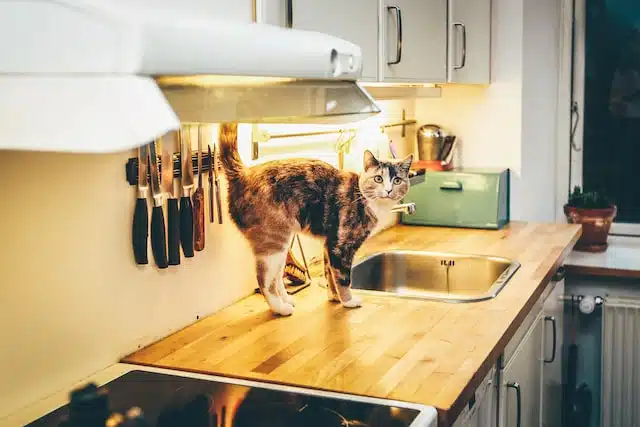
Choosing great pet food for happy healthy pets
There are lots of pet costs a pet parent forks out for, from bedding and toys to health and grooming supplies. Then there’s food. No matter how much you invest in feeding well and matching your pet’s food to its breed, age and so on, it will never go to waste. Lots of breeds have genetic predispositions to being more prone to certain health conditions.
Safeguard against illness and hereditary conditions
For example, Siamese cats are more prone to food allergies than many other cats. Persian cats often have breathing issues as they’re a brachycephalic breed. Things like hip dysplasia can affect bigger cats like the Maine Coon.
Food can be a wonderful way to do your best to help protect your pet against these potential health risks.
Quality of kitten food and beyond = quality of life
When it comes to pet health and wellness, quality food really isn’t something to skip. It’s the bedrock of what your pet will grow up to be from kitten to cat and from cat to super cat.
Good pet food brands will cater to the rapid developmental phases of early kittenhood. They supply the optimum energy levels and correct amounts of essential vitamins and minerals in just the right balance.
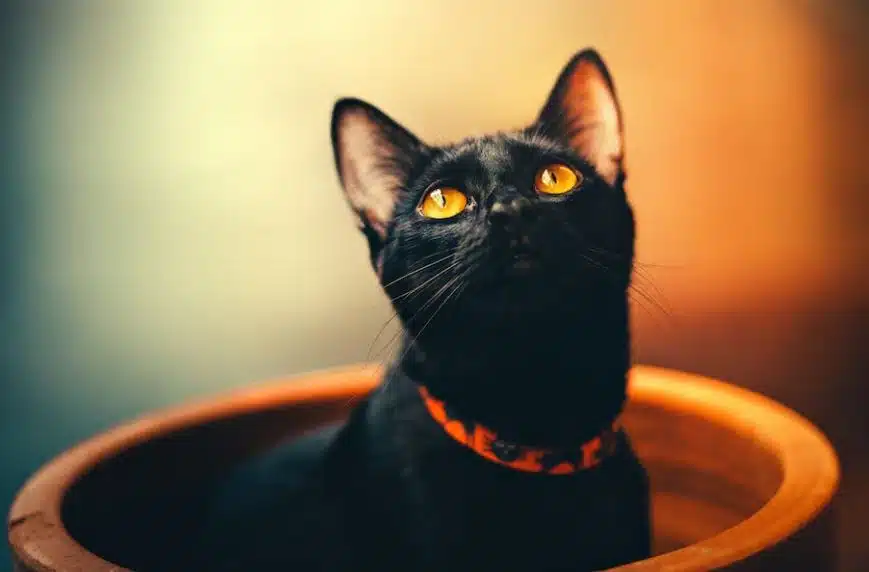
Let pet food guidelines guide you
When you’re looking for a pet food among the myriad options, it can be confusing making the right pick. However, you can easily get it right by choosing cat food that meets the Association of American Feed Control Official (AAFCO) or European Pet Food Industry (FEDIAF) pet food guidelines.
A quick Google search should tell you if the pet food brand you’re buying meets any of the above.
How much wet food to feed a kitten or cat?
If you’re wondering how much wet food to feed a kitten or cat then you’re probably choosing between wet and dry foods. Both dry cat food and wet have benefits and drawbacks.
For example, wet food contains water and that can help your cat avoid urinary tract infections. This is because they’re likely to be better hydrated. However, dry food is good for their teeth.
As you can see, it’s probably a good idea to feed your feline a mix of both and work towards the ideal balance based on their food preference. But whether you feed wet food only, dry food only or a mixture of both, don’t exceed the packet feeding guidelines.
For example, if you’re feeding a mix of wet and dry cat food, be sure to cut both down by half if you’re feeding half of each. The last thing you want is to accidently give a double portion by giving one wet and one dry.
And as companion animal vet Dr Cath Watson explains in this vlog post, if your pet is still heavier than healthier, gradually cut back on how much you’re feeding:
How to safeguard against obesity in pets
Obesity is a growing problem with pets – partially due to the rise in popularity of chunky social media pet-stars. Unfortunately it can lead to all kinds of serious chronic health conditions like heart disease and diabetes in dogs and cats. Not to mention being physically uncomfortable for them.
Sadly, it’s super-easy to overfeed your cuddlesome cat. If you’re already feeding them the prescribed amount of food according to the package guidelines and treating them on top, you’ve got a problem.
Scale back on their serving quantities. Especially if you’re using treats for positive reinforcement reward based training. You don’t have to feed them all their food in one go, you simply need to ration it right.
Read up on our National Pet Diabetes Month for tips to maintain your feline’s average cat weight.
Give your cat pet insurance for a soft landing
In addition to great food, a great way to keep kitty safe and healthy is to take up cat insurance. A pet plan helps ensure you’re not in the red when the unexpected happens and you land at the vet.
Your pet’s pawlicy can help pay for all sorts of medical procedures, from surgery and vet hospital stays to dental operations and medication – depending on the level of cover you opt for. Did you know that with PD Insurance third party liability cover is included in all our plans? And that you might be able to get discounted pet insurance for multiple pets on the one policy?
Click below to get one or more months of FREE pet insurance too!
Share On:

